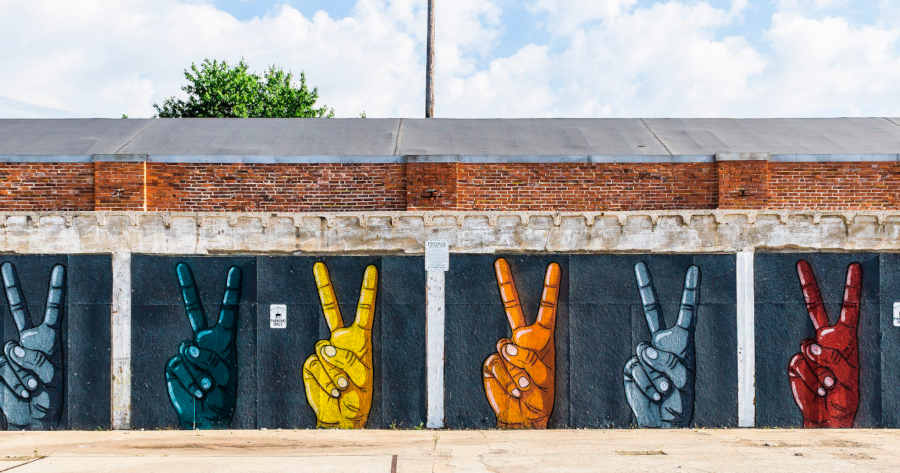“The Party told you to reject the evidence of your eyes and ears. It was their final, most essential command.”
About 5 years ago, I wrote a post on leadership myths and realities based on a book I co-authored with Dr. Barry Cohen over 30 years ago. Since that time, misinformation and disinformation have spread like wildfire creating a pervasive smoke that obscures reality. Making accurate discriminations about what is true and what is flagrantly fabricated has become increasingly difficult due to social media and advances in AI. It often feels like the amount of energy going into burning down the truth has resulted in a country in which blatant lies are overpowering facts.
My hypothesis in this post is that our inability to make accurate discriminations and our unwillingness to ask hard questions have led to a state of affairs in which myths often trump realities.
To make this phenomenon real, let me first zoom in on example of how myths surrounding homelessness have made it difficult to develop policies that actually help unhoused people find sustainable housing. After this one concrete example, I will shift to how this inability to distinguish between myths and realities is causing America to slide into a situation we couldn’t have imagined when the country was founded.
Homelessness, a harsh reality for millions of people around the world, is often shrouded in misconceptions. These myths create a barrier to understanding the complexities of the issue and hinder efforts to address the problems. This overview dismantles some of the most pervasive myths surrounding homelessness and reveals the human stories that lie beneath. Here are seven myths and the corresponding realities:
Myth 1: Everyone experiencing homelessness is mentally ill and/or abuses substances.
Reality: While there is a disproportionately higher rate of substance abuse and mental health issues with people experiencing homelessness, less than half are affected by these two problems. In fact, mental illness and substance abuse are more likely to be a consequence of homelessness itself. The stress and insecurity of living on the streets can exacerbate mental health problems and lead to self-destructive coping mechanisms. People who are experiencing homelessness are a diverse collection of individuals with unique stories and circumstances. They come from all walks of life, varying in age, race, gender, and socioeconomic background. Each person’s path to homelessness is different, and their needs and challenges are equally varied. It’s crucial to recognize this diversity and avoid generalizations that perpetuate harmful stereotypes and detract from efforts to address the root causes of homelessness. In truth, the best predictor of homelessness is a lack of affordable housing.
Myth 2: People experiencing homelessness don’t have skills.
Reality: Homelessness can be caused by a multitude of complex factors, including systemic issues, family violence, mental health issues, physical health issues, accidents at work, overwhelming bills, loss of employment, under-employment, inability to gain a new job, limited housing, high rents, drug and alcohol addiction, or any number of traumatic events. Many individuals experiencing homelessness possess a diverse range of skills, talents, and experiences. Some may have professional backgrounds, trade skills, or educational degrees. Others may have valuable life skills developed through overcoming adversity and navigating challenging situations. Nationwide, as many as 40-60% of people experiencing homelessness have a job, but struggle to maintain housing as rents rise and wages stagnate. There are few, if any, counties or states where a full-time minimum-wage worker can afford a modest apartment. At minimum wage, in many cities, a person would need to work over 80 hours a week to afford a one-bedroom.
Myth 3: Most people experiencing homelessness don’t want permanent housing – they are lazy, unambitious, or simply making bad choices.
Reality: Labeling people experiencing homelessness as lazy and unambitious is simply not supported by the facts and falls into the trap of blaming the victim. Job loss, economic hardship, domestic violence, incarceration and mental health struggles can all be devastating triggers. A single event, like a medical emergency with hefty bills, can spiral into eviction and homelessness, even for those with a strong work ethic. The affordable housing crisis further exacerbates the problem, with minimum wage jobs often failing to cover the exorbitant costs of rent. Most individuals experiencing homelessness desire stable housing. It provides safety, security, and a foundation to address other problems they might face. The real issue is that many homeless people may resist accepting the imposed conditions under which housing options may be available, e.g. “Treatment-First,” no smoking, no drugs, no dogs, mandatory religious participation, or unsafe/overcrowded spaces. Multiple studies clearly demonstrate that “Housing-First” approach, when combined with other supportive services, provides long-term success in lifting people out of homelessness.
Myth 4: Providing people with housing will not solve the problems underlying homelessness.
Reality: Getting people safe, stable housing is the most effective solution to the problem. Houston, for example, has reduced homelessness by 60% since 2011 by moving unhoused persons into apartments and providing them with the care they need to stay housed. They were able to achieve these results by encouraging nonprofits to work in collaboration rather than competing, and by reducing regulations that make it impossible to build new apartments quickly and cost-effectively. The most effective solution to homelessness is to get people off the streets and into housing as quickly as possible and as permanently as possible. Treatment interventions are more likely to succeed if a person has permanent housing and some level of support depending upon need.
Myth 5: People experiencing homelessness move to cities that provide the best services and have the best weather.
Reality: Research and data consistently demonstrate that most people experiencing homelessness become homeless in their own communities and remain there. For example, a 2017 study in Hillsborough County, Florida, found that 76% of homeless individuals had lived in the county for at least a year before becoming homeless. Similarly, in California, where this myth is often perpetuated, experts state that most homeless individuals are from the communities where they are currently living. While some individuals may move in search of better opportunities, this is not the primary driver of homelessness.
Myth 6: People experiencing homelessness are dangerous.
Reality: People experiencing homelessness are extremely resilient and survive under very difficult circumstances. Studies show that people experiencing homelessness are more likely to be victims of violence than perpetrators. They face constant vulnerability and struggle to find safe spaces to sleep. The fear stems from a lack of understanding and often fuels social exclusion. Every night thousands of Americans are forced to put their life at risk by sleeping on the street. The overwhelming majority of people experiencing homelessness are not dangerous.
Myth 7: Giving money directly to homeless people enables them and perpetuates the problem.
Reality: While some homeless people may misuse the funds, many need them for immediate essentials like food, hygiene products, or transportation to job interviews. Furthermore, studies show that unconditional cash assistance to those in need can be incredibly effective in improving their lives and ultimately escaping homelessness. One study published in the journal Science found that cash transfers to homeless individuals in Vancouver led to a significant decrease in shelter stays and an increase in spending on essential items like food and clothing. Furthermore, allowing individuals to decide how to spend their money empowers them and respects their dignity. While providing essential services like shelter and healthcare is crucial, cash assistance can offer immediate relief and allow individuals to address their most pressing needs in a way that best suits their circumstances. Direct cash assistance alone, however, is rarely sufficient to achieve the desired outcome. Coordinated entry systems, organizational collaboration, and a support network are still critical to success.
In short, homelessness is a complex and multi-faceted issue, and solving it can seem daunting. However, dismantling these myths is a crucial first step. By recognizing the human stories behind the statistics, we can foster empathy and create effective solutions. And there is hope, because there are solutions that have been found to be effective that any community can employ. This can involve advocating for increased affordable housing, investing in mental health services, and offering support programs that empower individuals to rebuild their lives. Generosity and compassion are essential for success.
Ultimately, ending homelessness requires a shift in perspective. It’s not about judging individuals but about recognizing the systemic issues that contribute to their situation. Here are some key points to consider:
- On any given day, there are over 500,000 homeless people in the U.S.
- Over 230,000 sleep on the street
- 70% are men; 30% are women
- 33% are families with children, 67% are individuals
- 50% are non-white, 40% are African American/Black
- 18% are chronically homeless
- The top 10 states (comprising over 50% of the homeless population) are: California, New York, Florida, Texas, Washington, Massachusetts, Oregon, Pennsylvania, Illinois, and Colorado.
By dispelling these myths and acknowledging the realities, we can pave the way for a more compassionate and effective approach to this complex social challenge.
I could zoom in on all those myths to expand the science supporting the realities, but I’m now going to zoom out, in order to look at the context in which this particular issue is taking place. Here are ten myths that are not only masking the realities of our culture but are also destroying hope and trust in America. They make solving homelessness and many other challenges more difficult because they deny the truth of our current situation.
Myth 1: The American dream is attainable for everyone.

Reality: Even hard working, determined people are often thwarted in their desire to achieve upward mobility and financial success. While the American Dream has been realized by millions of people born into poverty or forced to leave their birth countries, systemic inequalities based on race, class, and background create significant barriers for marginalized groups. And representing America as the beacon of liberal democracy around the world is simply not true. Ta-Nehisi Coates would say that democracy in America didn’t even start to become a reality until 1965.
Myth 2: America is a colorblind society.
Reality: This myth asserts that racial discrimination is a thing of the past and that opportunities are equally available to all, regardless of race. However, racial disparities persist in various aspects of life, including education, employment, housing, and the criminal justice system. The reaction to affirmative action programs that address historical inequalities demonstrates how many people actually believe the myth that we have evolved to a post racial state.
Myth 3: The free market is always the best solution.
Reality: This myth promotes the idea that unregulated markets lead to optimal outcomes and that government intervention is inherently inefficient or unnecessary. History paints a different picture. We have seen in the past that unchecked capitalism can result in monopolies, exploitation, oppression, and economic instability. It is telling that some of the richest men, like Elon Musk, are so fiercely opposed to any form of regulation. Their mantra is “don’t fence me in.” And yet what we are seeing with unchecked technology titans clearly demonstrates what happens when big business is not regulated. In the technology example, people are hired to addict children to video games and other unhealthy habits by using “clickbaits” to manipulate and command their attention. Clickbait, of course, is a content designed to attract readers, watchers, or listeners. It is often misleading, sensationalized, deceptive, and/or perpetuates harmful myths.
Myth 4: Taxes are bad.
Reality: This myth portrays taxes as a burden on individuals and businesses, hindering economic growth. While excessive taxation can be problematic, taxes fund essential public services like education, infrastructure and health care. In a previous post on why taxes are necessary, I outlined what happens when taxes do not generate enough income to cover expenses. In short, the United States today has a $35 trillion dollar debt and an annual deficit of about $2 trillion. In 2024, total revenues will amount to about $4.5 trillion. Annual expenses will approach $6.5 trillion. Five programs account for about $5 trillion: social security, Medicare, Medicaid, defense, and interest. The reason we have reached this point is because politicians, starting with Reagan, pushed the idea of tax cuts to fuel supply side economics which has turned out to be a myth.
Myth 5: Welfare programs encourage dependency.
Reality: This myth claims that social safety nets disincentivize work and create a culture of dependence. Research shows, however, that most welfare recipients use these programs for temporary support while they seek employment or face hardship. There are multiple reasons people resent welfare for people who are struggling, but the myth above explains why it is so difficult to find the funds required to help people get through rough spots and get back on a path to recovery – every expenditure means adding to the deficit and the debt. Here are the facts:
- Medicaid: In 2023, the improper payment rate for Medicaid was 8.58%.
- SSI: In 2023, the improper payment rate for SSI was 9.2%.
- Pell Grants: In 2023, the improper payment rate for the Pell Grant Program was 2.82%.
- Head Start: In 2023, the improper payment rate for the Head Start Program was 1.83%.
- Child Care: In 2023, the improper payment rate for the Child Care Program was 1.15%.
- Lifeline (Obama Phone): In 2023, the improper payment rate for the Lifeline Program was 2.18%.
In spite of the myths surrounding welfare programs, the reality is that benefit determination practices are effective, and significant resources are dedicated to assessing program integrity.
Myth 6: Immigrants are a drain on the economy.
Reality: This myth suggests that immigrants take jobs from native-born workers and strain public resources. Studies demonstrate, however, that immigrants contribute significantly to the economy by filling labor shortages, starting businesses, and paying taxes. The myths about immigration and the economy constitute the underpinnings for Trump’s campaign in 2024. He is counting on his ability to perpetuate sufficient lies and myths to overcome the realities that his Presidency would mean. The reality is that a healthy immigration system fuels a healthy economy AND our economy under Biden and Harris is the strongest in the world: less than 4 percent unemployment, less than 3 percent inflation, 15 million new jobs in 4 years, wages increasing faster than prices, and manufacturing and infrastructure investments making our country more secure. We will find out on November 5 whether myths Trump realities. I could say, “God help us if that happens”, but that would just perpetuate another myth.
Myth 7: Climate change is a hoax.
Reality: This myth denies overwhelming scientific consensus that human activities are causing global warming and its associated consequences. The impacts of climate change are already being felt worldwide, including rising sea levels, extreme weather events and biodiversity loss. I don’t need to cite the hundreds of books and articles that support the evidence, but I will recommend Richard Powers new book, Playground, that focuses on how we are killing our oceans. First he spoke for the trees, and now he speaks for the seas. Enough said. Oy.
Myth 8: Guns make us safer.
Reality: This myth promotes the idea that widespread gun ownership deters crime and enhances personal safety. However, statistics show a strong correlation between gun prevalence and gun violence, including homicides, suicides, and accidental shootings. For a fuller explanation, please go to the posts I wrote on school shootings and the number of deaths per day associated with guns in America. Sadly, the number has increased from 91 per day when I wrote the post to about 140 per day now.
Myth 9: The media is always biased.
Reality: This myth claims that news outlets have inherent political agendas and cannot be trusted to report objectively. While media bias does exist, reputable news organizations strive for accuracy and fairness, relying on verified sources and fact-checking. I admit to being a news junkie. I spend almost two hours each morning reading the New York Times which I believe makes genuine attempts to fact-check it’s articles and admit mistakes when it makes them. I will say, however, that I have been disturbed over the past few years by its over-sensitivity to balance in politics that it often presents false equivalencies. I also find it succumbs to the need for readership by focusing more on sensational, attention-getting, negative events than it does on some of the positive things happening in the world. Finally, and most disturbingly, I have experienced the overall media as not providing a balanced perspective on the war in the Middle East. While my personal perspective is that Netanyahu and his far-right war cabinet have reacted disproportionately and, possibly illegally, in Gaza, Lebanon, and the West Bank, I think every report should begin with 1) Hamas, Hezbollah and Iran started these wars, 2) October 7th was a horrific and heinous event, 3) Islamic terrorist organizations continue to lob missiles into Israel and refuse to return hostages, and 4) all of these countries have a mission devoted to eliminating Jews and Israel. In my mind, every report should begin there before reporting on the atrocities and tragedies on the ground.
Myth 10: American is the greatest country in the world.
Reality: This myth promotes the idea of American exceptionalism, suggesting it is superior to all other nations. While America has many strengths and provides enormous opportunity, it also faces significant challenges like homelessness, poverty, inequality, extremism, gun violence and political polarization. No need to say more. The discussion above sufficiently dispels this myth.
All of these myths, often perpetuated through political rhetoric, social media, and selective reporting, distort reality and hinder informed decision-making. It is crucial to critically examine these narratives, seek evidence-based information, and engage in constructive dialogue to address the complex issues facing America today. By dispelling these myths, we can create a more informed and equitable society for all. To gain a better understanding of the problems and possibilities involved in finding sustainable solutions to complex problems, it is essential to start by exploring common misconceptions and the actual facts. This approach is particularly crucial when addressing seemingly intractable issues like the ones described in this post. And yet, I am willing to bet, that most people are much more familiar with the myths I have cited above than with the realities dispelling them. Ask yourself that question.
The problem is that stories sell better than facts – indeed, about 20 times better. This problem is compounded by the fact that social media platforms like TikTok and X increase viewers by telling stories and perpetuating myths. The facts are that Tik Tok has 170 million American viewers and Elon Musk has over 200 million followers on X. These platforms are not exactly known for fact-checking or seriously seeking the truth. For comparison, the New York Times has 10 million readers.
I’m hoping we will all do a better job of naming and acknowledging the myths to which we may subscribe. I’m hoping more of us will start asking the question, “how much of this statement is grounded in reality and/or undermined by myth?” Indeed, as George Orwell warned, I’m hoping we don’t “reject the evidence in front of our eyes and ears.” Finally, I’m hoping that more people start making better discriminations about what is soundly true and what is simply false. May it be so.
P.S. If you made it through this post, you are one hell of a dedicated and devoted reader. Thank you. I welcome your fact checking and your feedback on what I missed.
Also published on Medium.




A thorough and thought provoking missive my friend-thank you!